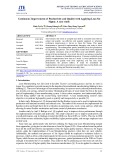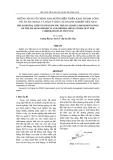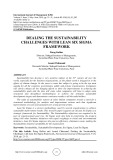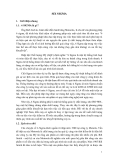
67
4
CHAPTER
10 Technical
Tools to Master
While on a Six
Sigma Team
In Chapter 3, we reviewed the steps a team goes through as they
attempt to improve the sigma performance of a process.
Chapter 4 addresses the 10 most important technical tools a
Six Sigma team member needs to master as they progress through
the DMAIC methodology.
While these tools are considered technical in nature, most of
them are relatively easy to learn and apply. They are covered in the
order they are used in the DMAIC methodology.
Tool #1 The Critical to Quality (CTQ) Tree
The critical to quality tree is used in the second tollgate of the De-
fine phase of DMAIC. It is used to brainstorm and validate the
needs and requirements of the customer of the process targeted
for improvement.

68 SIX SIGMA FOR EVERYONE
The steps in creating a CTQ tree are as follows:
• Identify the customer of the process targeted for improve-
ment. A customer is the recipient of the product or service
of the process.
• Identify the need of the customer, that is either the product
or service desired by the customer.
• Identify the first level of requirements of the need, that is,
some characteristic of the need that determines whether
the customer is happy with the need.
• Drill down to more detailed level(s) of the requirement if
necessary. Some requirements of the customer dictate
greater specificity. If so, the tree will need to be created in
greater detail.
Figure 4.1 shows an example of a CTQ tree for a health care
provider where the customer of the patient registration process is
the patient. The need of the patient is to be registered. However,
you can also see that there are requirements of the patient that will
determine whether the patient has been satisfactorily registered.
Figure 4.1 Health care provider CTQ tree.
Registration
General
(need)
Behavioral
(requirement)
Accuracy
Type of room
Hospital ward
Timeliness
Courtesy
Need 1st Level 2nd Level

10 Technical Tools to Master While on a Six Sigma Team 69
Keys to Using This Tool
• Always start with the need of the customer.
• State the need as a noun with no adjectives to describe it.
• Keep moving left to right until you describe how to measure
the detailed requirements. If you have described a measure-
ment, you have gone to far (e.g., a requirement could be
speed or timeliness, but if you put it in minutes you have de-
scribed a measurement).
•
Once you have started a branch for the tree, all those
branches should be a greater detail of the preceding require-
ment, not a new requirement.
Tool #2 The Process Map
During the Define phase, the project team creates the first of sev-
eral process maps. A process map is a picture of the current steps
in the process targeted for improvement.
A process map has five major categories of work from the iden-
tification of the suppliers of the process, the inputs the suppliers
provide, the name of the process, the output of the process, and
the customers of the process. Each of these steps is summarized
as SIPOC to indicate to the team the steps that must be con-
ducted to complete a process map.
There are four stages of process mapping. The first stage is
what the project team creates during the Define stage of project
work. It is the high-level process map because the project team fo-
cuses in on the five to seven highest level steps in the current pro-
cess. Sometimes there will be less than five or more than seven
but most teams should strive to have five to seven.
The second step in process mapping occurs during the Analysis
stage. Here, the original high-level process map is created in more
detail. This second type of process map is called the subprocess
map. The third type of process map is created during the Improve
stage of DMAIC. This map is the improved map of what the new
process should be. Ergo, it is called the should-be map. Finally, the
fourth type of process map is the could-be map, usu
ally generated

70 SIX SIGMA FOR EVERYONE
in the Design for Six Sigma application. (Design for Six Sigma is
not addressed in this book.)
Figure 4.2 shows an example of a high-level process map for a
hospital lab test ordering process. In addition, we have also talked
about the subprocess map created in the Analysis stage of DMAIC.
Figure 4.3 shows the same hospital lab test ordering process with
one of the high-level steps drilled down in greater detail showing
the hospital lab test subprocess map.
Keys to Using This Tool
• Don’t rush to the creation of the should-be map, this occurs
in the Improve stage of DMAIC.
•
Capture all of the steps as they actually occur in the process,
not the way you would like to see the steps in the process.
• Use verbs or adjectives to describe steps in the process.
• Use unqualified nouns to describe the output and inputs of
the process.
Figure 4.2 Hospital lab test ordering—high-level process map.
CustomersOutputs
Hospital lab
test ordering
Process
InputsSuppliers
Phlebotomy
department Order
Doctor
orders
lab
Doctor
receives lab
report
Place
order
Lab
result Patient
Care
Team
Obtain
specifications
Specifications
are compared
to lab order
Test
Report

71
Figure 4.3 Subprocess map—hospital lab test ordering process.
CO
CustomersOutputs
P
Process
IS
InputsSuppliers
Specifications
compared to lab order
Spin specimen
for test
Test
Place
order
Obtain
specifications Test Report
Wait for
order
Review
specification
Wait for
results
Prepare
report
Review
report
Verify
specification
with care
specialist













![Tối ưu hóa hiệu suất hệ thống: Bài thuyết trình [Chuẩn nhất]](https://cdn.tailieu.vn/images/document/thumbnail/2025/20251107/hiepdz2703@gmail.com/135x160/35941762488193.jpg)




![Bài giảng Quản trị chất lượng trong công nghiệp thực phẩm [chuẩn nhất]](https://cdn.tailieu.vn/images/document/thumbnail/2025/20250805/vijiraiya/135x160/637_bai-giang-quan-tri-chat-luong-trong-cong-nghiep-thuc-pham.jpg)

![Đề cương bài giảng Kỹ năng hoạt động công nghiệp [mới nhất]](https://cdn.tailieu.vn/images/document/thumbnail/2025/20250715/kimphuong1001/135x160/76971752564028.jpg)


![Bài giảng Kỹ thuật điều độ trong sản xuất và dịch vụ [mới nhất]](https://cdn.tailieu.vn/images/document/thumbnail/2025/20250630/dcbaor/135x160/13121751251866.jpg)


